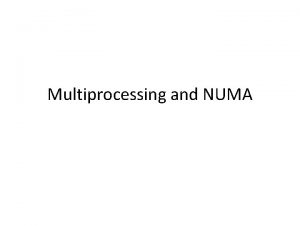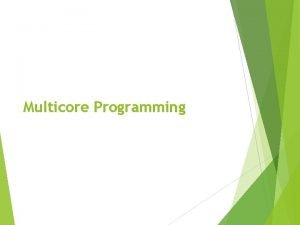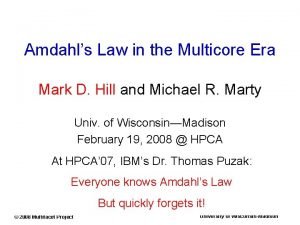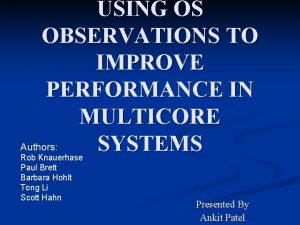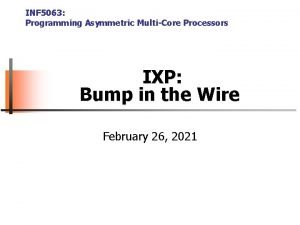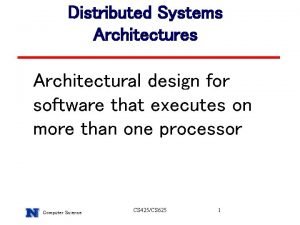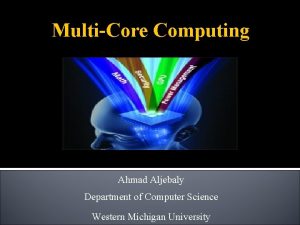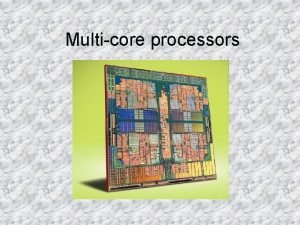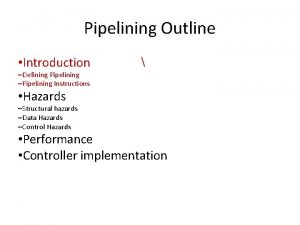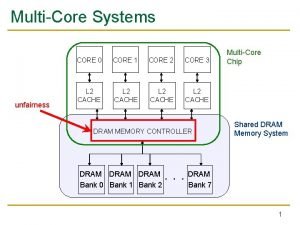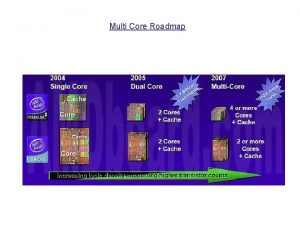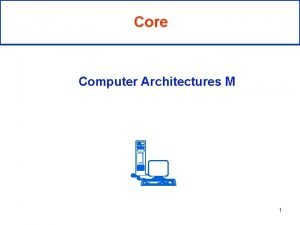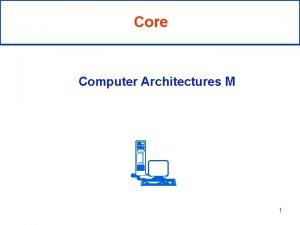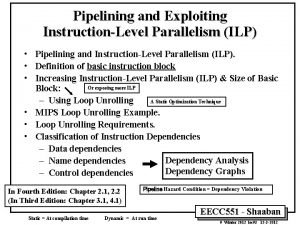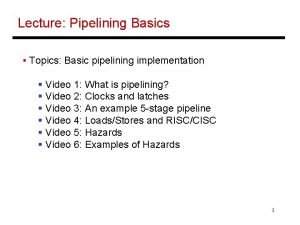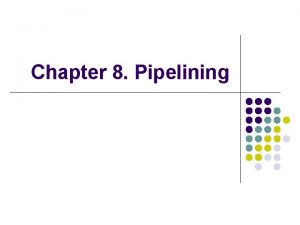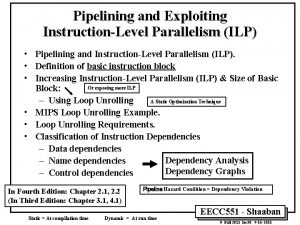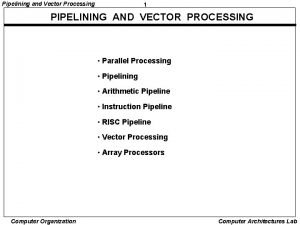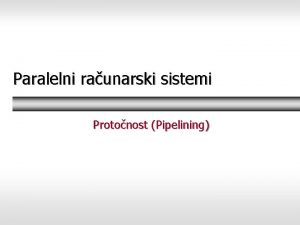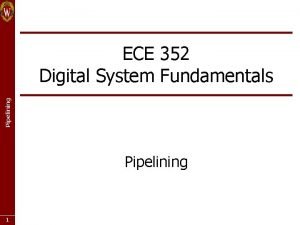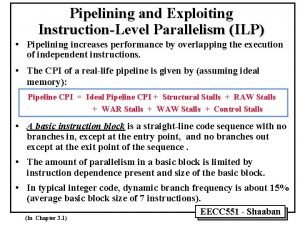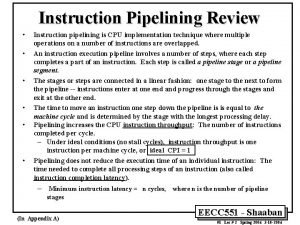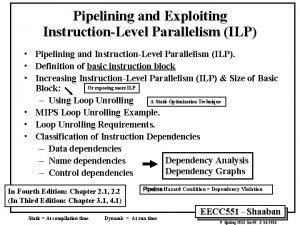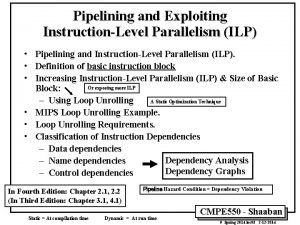Pipelining for Multi Core Architectures 1 MultiCore Technology































- Slides: 31

Pipelining for Multi. Core Architectures 1

Multi-Core Technology 2004 Single Core 2005 Dual Core 2007 Multi Core 4 or more cores Cache + Cache Core ore m 2 X res co 2 or more cores + Cache 2

Why multi core ? • Difficult to make single core clock frequencies even higher • Deeply pipelined circuits: – heat problems – Clock problems – Efficiency (Stall) problems • Doubling issue rates above today’s 3 6 instructions per clock, say to 6 to 12 instructions, is extremely difficult – issue 3 or 4 data memory accesses per cycle, – rename and access more than 20 registers per cycle, and – fetch 12 to 24 instructions per cycle. • Many new applications are multithreaded • General trend in computer architecture (shift towards more parallelism) 3

Instruction level parallelism • Parallelism at the machine instruction level • The processor can re order, pipeline instructions, split them into microinstructions, do aggressive branch prediction, etc. • Instruction level parallelism enabled rapid increases in processor speeds over the last 15 years 4

Thread level parallelism (TLP) • This is parallelism on a more coarser scale • Server can serve each client in a separate thread (Web server, database server) • A computer game can do AI, graphics, and sound in three separate threads • Single core superscalar processors cannot fully exploit TLP • Multi core architectures are the next step in processor evolution: explicitly exploiting TLP 5

What applications benefit from multi core? • • Database servers Web servers (Web commerce) Multimedia applications Scientific applications, CAD/CAM • In general, applications with Thread-level parallelism (as opposed to instruction level parallelism) Each can run on its own core 6

More examples • Editing a photo while recording a TV show through a digital video recorder • Downloading software while running an anti virus program • “Anything that can be threaded today will map efficiently to multi core” • BUT: some applications difficult to parallelize 7

Core 2 Duo Microarchitecture 8

Without SMT, only a single thread can run at any given time L 2 Cache and Control L 1 D Cache D TLB Integer Floating Point Schedulers Uop queues Rename/Alloc BTB Trace Cache u. Code ROM Bus Decoder BTB and I TLB Thread 1: floating point 9

Without SMT, only a single thread can run at any given time L 2 Cache and Control L 1 D Cache D TLB Integer Floating Point Schedulers Uop queues Rename/Alloc BTB Trace Cache u. Code ROM Bus Decoder BTB and I TLB Thread 2: integer operation 10

SMT processor: both threads can run concurrently L 2 Cache and Control L 1 D Cache D TLB Integer Floating Point Schedulers Uop queues Rename/Alloc BTB Trace Cache u. Code ROM Bus Decoder BTB and I TLB Thread 2: Thread 1: floating point integer operation 11

But: Can’t simultaneously use the same functional unit L 2 Cache and Control L 1 D Cache D TLB Integer Floating Point Schedulers Uop queues Rename/Alloc BTB Trace Cache Bus Decoder BTB and I TLB Thread 1 Thread 2 IMPOSSIBLE u. Code ROM This scenario is impossible with SMT on a single core (assuming a single 12 integer unit)

Multi-core: threads can run on separate cores Integer L 1 D Cache D TLB Floating Point Schedulers Uop queues Rename/Alloc BTB Trace Cache u. Code ROM L 2 Cache and Control L 1 D Cache D TLB BTB and I TLB Thread 1 Floating Point Schedulers Uop queues Rename/Alloc BTB Trace Cache u. Code ROM Decoder Bus Decoder Integer BTB and I TLB Thread 2 13

Multi-core: threads can run on separate cores Integer L 1 D Cache D TLB Floating Point Schedulers Uop queues Rename/Alloc BTB Trace Cache u. Code ROM L 2 Cache and Control L 1 D Cache D TLB BTB and I TLB Thread 3 Floating Point Schedulers Uop queues Rename/Alloc BTB Trace Cache u. Code ROM Decoder Bus Decoder Integer BTB and I TLB Thread 4 14

Combining Multi-core and SMT • Cores can be SMT enabled (or not) • The different combinations: – Single core, non SMT: standard uniprocessor – Single core, with SMT – Multi core, non SMT – Multi core, with SMT: our fish machines • The number of SMT threads: 2, 4, or sometimes 8 simultaneous threads • Intel calls them “hyper threads” 15

SMT Dual-core: all four threads can run concurrently Integer L 1 D Cache D TLB Floating Point Schedulers Uop queues � Rename/Alloc BTB Trace Cache u. Code ROM L 2 Cache and Control L 1 D Cache D TLB BTB and I TLB Thread 1 Thread 3 Floating Point Schedulers Uop queues Rename/Alloc BTB Trace Cache u. Code ROM Decoder Bus Decoder Integer BTB and I TLB Thread 2 Thread 4 16

L 2 cache L 1 cache CORE 0 L 1 cache CORE 1 L 1 cache CORE 0 CORE 1 Multi-Core and caches coherence L 1 cache L 2 cache L 3 cache memory Both L 1 and L 2 are private Examples: AMD Opteron, AMD Athlon, Intel Pentium D A design with L 3 caches Example: Intel Itanium 2 17

The cache coherence problem • Since we have private caches: How to keep the data consistent across caches? • Each core should perceive the memory as a monolithic array, shared by all the cores 18

The cache coherence problem Suppose variable x initially contains 15213 Core 1 Core 2 Core 3 Core 4 One or more levels of cache multi core chip Main memory x=15213 19

The cache coherence problem Core 1 reads x Core 1 Core 2 Core 3 Core 4 One or more levels of cache x=15213 One or more levels of cache multi core chip Main memory x=15213 20

The cache coherence problem Core 2 reads x Core 1 Core 2 Core 3 Core 4 One or more levels of cache x=15213 One or more levels of cache multi core chip Main memory x=15213 21

The cache coherence problem Core 1 writes to x, setting it to 21660 Core 1 Core 2 Core 3 Core 4 One or more levels of cache x=21660 One or more levels of cache x=15213 One or more levels of cache multi core chip Main memory x=21660 assuming write through caches 22

The cache coherence problem Core 2 attempts to read x… gets a stale copy Core 1 Core 2 Core 3 Core 4 One or more levels of cache x=21660 One or more levels of cache x=15213 One or more levels of cache multi core chip Main memory x=21660 23

The Memory Wall Problem 24

Memory Wall 100 10 1 µProc 60%/yr. “Moore’s Law” (2 X/1. 5 yr ) Processor-Memory Performance Gap: (grows 50% / year) DRAM 9%/yr. (2 X/10 yrs) CPU 1980 1981 1982 1983 1984 1985 1986 1987 1988 1989 1990 1991 1992 1993 1994 1995 1996 1997 1998 1999 2000 Performance 1000 25

Latency in a Single PC Ratio Memory Access Time CPU Time THE WALL 26

Processor Pentium 4 Cache hierarchy L 1 I (12 Ki) L 1 D (8 Ki. B) Cycles: 2 L 2 cache (512 Ki. B) Cycles: 19 L 3 cache (2 Mi. B) Cycles: 43 Memory Cycles: 206 27

Technology Trends Logic: DRAM: Disk: Capacity Speed (latency) 2 x in 3 years 4 x in 3 years 2 x in 10 years DRAM Generations Year Size 1980 1983 1986 1989 1992 1996 1998 2000 2002 2006 64 Kb 256 Kb 1 Mb 4 Mb 16 Mb 64 Mb 128 Mb 256 Mb 512 Mb 1024 Mb 16000: 1 (Capacity) Cycle Time 250 ns 220 ns 190 ns 165 ns 120 ns 110 ns 100 ns 90 ns 80 ns 60 ns 4: 1 (Latency) 28

Processor-DRAM Performance Gap Impact: Example • To illustrate the performance impact, assume a single issue pipelined CPU with CPI = 1 using non ideal memory. • The minimum cost of a full memory access in terms of number of wasted CPU cycles: Year CPU speed MHZ 1986: 8 1989: 33 1992: 60 1996: 200 1998: 300 2000: 1000 2003: 2000 CPU cycle ns 125 30 16. 6 5 3. 33 1. 5 Memory Access Minimum CPU cycles or instructions wasted ns 190 165 120 110 100 90 80 190/125 - 1 = 0. 5 165/30 -1 = 4. 5 120/16. 6 -1 = 6. 2 110/5 -1 = 21 100/3. 33 -1 = 29 90/1 - 1 = 89 80/. 5 - 1 = 159 29

Main Memory • Main memory generally uses Dynamic RAM (DRAM), which uses a single transistor to store a bit, but requires a periodic data refresh (~every 8 msec). • Cache uses SRAM: Static Random Access Memory – No refresh (6 transistors/bit vs. 1 transistor/bit for DRAM) • Size: DRAM/SRAM 4 -8, Cost & Cycle time: SRAM/DRAM 8 -16 • Main memory performance: – Memory latency: • Access time: The time it takes between a memory access request and the time the requested information is available to cache/CPU. • Cycle time: The minimum time between requests to memory (greater than access time in DRAM to allow address lines to be stable) – Memory bandwidth: The maximum sustained data transfer rate between main memory and cache/CPU. 30

Architects Use Transistors to Tolerate Slow Memory • Cache – Small, Fast Memory – Holds information (expected) to be used soon – Mostly Successful • Apply Recursively – Level one cache(s) – Level two cache • Most of microprocessor die area is cache! 31
 Waiting line management
Waiting line management Multi loop pid controller regolatore pid multi loop
Multi loop pid controller regolatore pid multi loop Speedy transactions in multicore in-memory databases
Speedy transactions in multicore in-memory databases Multicore packet scheduler samsung
Multicore packet scheduler samsung Multiprocessor vs multicore
Multiprocessor vs multicore Multiprocessor programming
Multiprocessor programming And eat
And eat Cache craftiness for fast multicore key-value storage
Cache craftiness for fast multicore key-value storage Multicore vs multiprocessor
Multicore vs multiprocessor Obs multicore
Obs multicore Asymmetric multicore processing
Asymmetric multicore processing Autosar multicore
Autosar multicore Modular product architectures
Modular product architectures Database storage architecture
Database storage architecture Ansi sparc
Ansi sparc Backbone network architectures
Backbone network architectures Autoencoders, unsupervised learning, and deep architectures
Autoencoders, unsupervised learning, and deep architectures George schlossnagle
George schlossnagle Modular vs integral product architecture example
Modular vs integral product architecture example Gui architectures
Gui architectures Database system architectures
Database system architectures Cdn architectures
Cdn architectures Scalable web architectures
Scalable web architectures Rolap in data warehouse
Rolap in data warehouse Isa instruction
Isa instruction Ecommerce server
Ecommerce server Banking system architecture diagram
Banking system architecture diagram Backbone network architectures
Backbone network architectures Cache coherence for gpu architectures
Cache coherence for gpu architectures Why systolic architectures
Why systolic architectures Multi core processor example
Multi core processor example Multi core processor history
Multi core processor history




